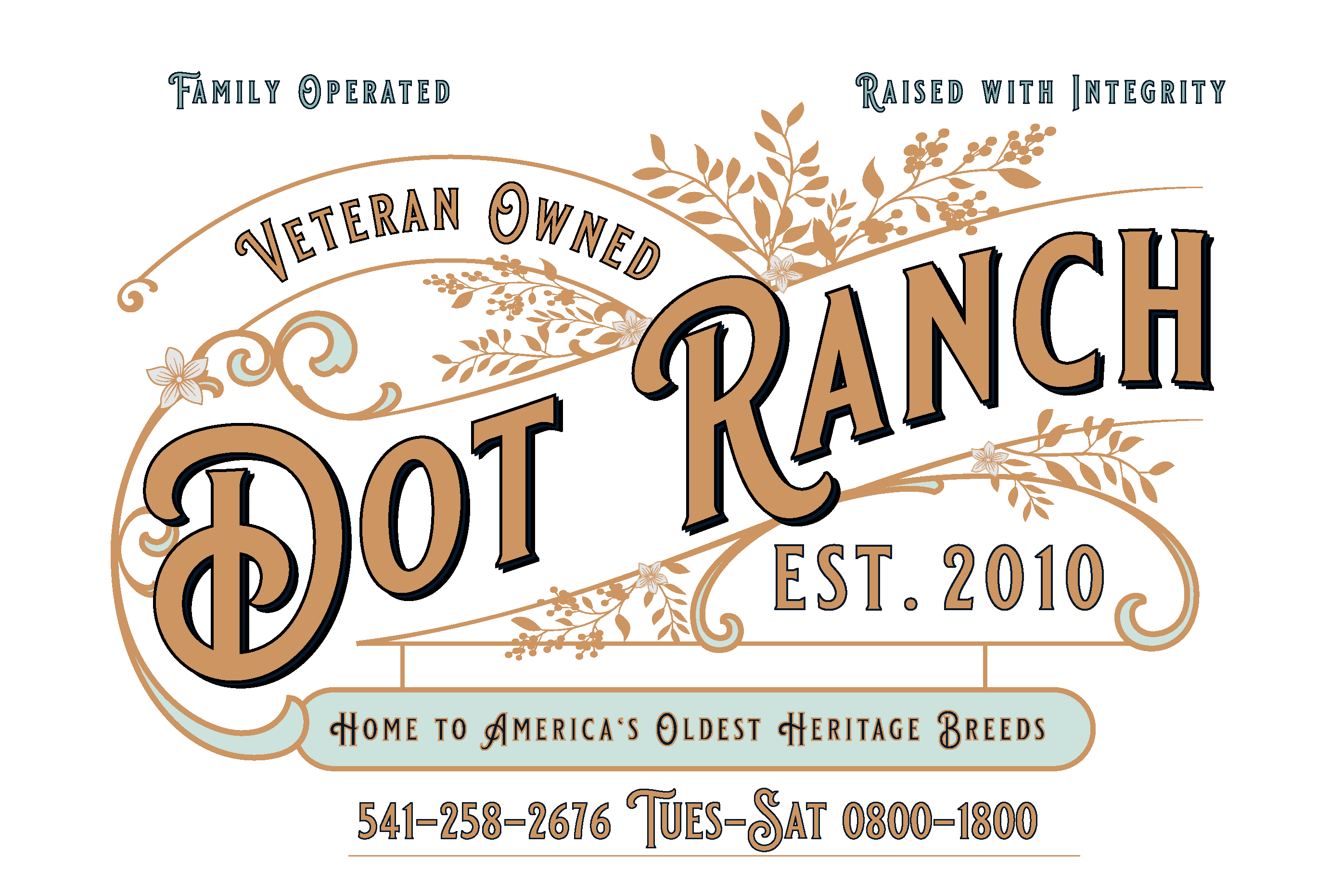2017 Navajo-Churro Breeding Groups
A Cautionary Tale, and a Call to Action
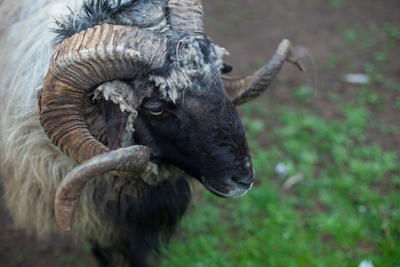 This is the first year that we use only four horned rams for breeding, but there are special circumstances. Last year, right after shearing, Teddy Bear and our own DoT Lt. Haverson got into a fight that ended with their horns locked together. They were so tightly stuck that we had to cut Teddy Bear's horns to pull them apart, and Lt. Haverson suffered fatal injuries that required a humane ending. Teddy Bear began having seizures, but seemed to be still enjoying life. Because his genetics are entirely new to the NW, and because he did not seem to be having a loss in quality of life, we made the decision to try to get some more lambs out of him before putting him down. We put him in with a select group of fall ewes, only to have a mere 20% return on lambs. So, for a Hail Mary pass, we placed Teddy Bear in with 58 ewes for one final romp. The results were far more than we expected, and Teddy Bear has left a wonderful legacy of lambs with us. We're keeping two of his ram lambs for at least a few more years, both off of completely unrelated ewes from two different Navajo breeders, from very different parts of Navajo Nation. As sad as it is to lose two of our best rams to one incident, this is the sort of thing that ranchers all around the world face. Sometimes circumstances come up outside of our control, and despite best efforts, there are losses. With a breed like Navajo-Churro sheep, which already has a constricted gene pool, it's important to keep a few redundancies in place to avoid losing entire bloodlines to accident, predator, or loss to drought and disease.
This is the first year that we use only four horned rams for breeding, but there are special circumstances. Last year, right after shearing, Teddy Bear and our own DoT Lt. Haverson got into a fight that ended with their horns locked together. They were so tightly stuck that we had to cut Teddy Bear's horns to pull them apart, and Lt. Haverson suffered fatal injuries that required a humane ending. Teddy Bear began having seizures, but seemed to be still enjoying life. Because his genetics are entirely new to the NW, and because he did not seem to be having a loss in quality of life, we made the decision to try to get some more lambs out of him before putting him down. We put him in with a select group of fall ewes, only to have a mere 20% return on lambs. So, for a Hail Mary pass, we placed Teddy Bear in with 58 ewes for one final romp. The results were far more than we expected, and Teddy Bear has left a wonderful legacy of lambs with us. We're keeping two of his ram lambs for at least a few more years, both off of completely unrelated ewes from two different Navajo breeders, from very different parts of Navajo Nation. As sad as it is to lose two of our best rams to one incident, this is the sort of thing that ranchers all around the world face. Sometimes circumstances come up outside of our control, and despite best efforts, there are losses. With a breed like Navajo-Churro sheep, which already has a constricted gene pool, it's important to keep a few redundancies in place to avoid losing entire bloodlines to accident, predator, or loss to drought and disease.

This is part of why it's so important that Navajo-Churro sheep be bred and freely traded across America, and not just condensed in small, isolated pockets of specific geographic areas.
Currently, in 2017, there are some people who adamantly claim that Navajo-Churro Sheep are no longer Navajo-Churro Sheep if they leave the Southwest. We call bullpucky on this statement. This, frankly, is like saying that a Canada Goose that lays its eggs in Oregon has offpsring that are now Oregon Geese, not Canada Geese. A Concord grape is still a Concord grape even if it's grown far from Massachusetts. By this twisted logic, every non-Navajo breeder, regardless of location, is no longer breeding Navajo-Churro Sheep, because they aren't Navajo-which includes the very people who make this ostentatious claim.
Here at Dot Ranch, we find this ridiculous, and counter productive to preserving the genetic health of the breed. It's about time that we call out the hypocrisy of non-Navajo breeders trying to dictate just what a Navajo-Churro sheep really is. If people truly want to ensure that Navajo-Churro Sheep remain true to their origins, without genetic drift or bottlenecking occuring, breeders all across the country need to work together, and keep the genes flowing from flock to flock. If there are concerns about the "authenticity" of a flock, or an animal, the people who need to be consulted are the Navajo shepherds who have been breeding these sheep for hundreds of years, not outsiders with a mere handful of decades, or sometimes merely years worth of experience. Indigenous society is based around some very simple truths which modern Western culture seems to have lost, including a respect and reverence for our elders. Too many of the non-profits working with Native peoples have excluded elder input, due to Western prejudices and ageism. Here at Dot Ranch, we value our elders, and rely on their guidance to help steer us when we're heading towards the wash-out. We implore our fellow breeders to strive to do the same. The infighting and divisiveness between non-Native breeders in different geographic regions is both confusing to newcomers, and damaging to the very people who you're claiming to want to help. Diversity is key to surviving what ever our changing environment and world can throw at us, both in genetics, and in responses to adversity.
The only way to maintain that diversity is to continue to breed these sheep across a wide range of conditions and locations, with a program of continuous trade in animals and ideas, so that no matter what happens, there will always be some insulation against extinction.
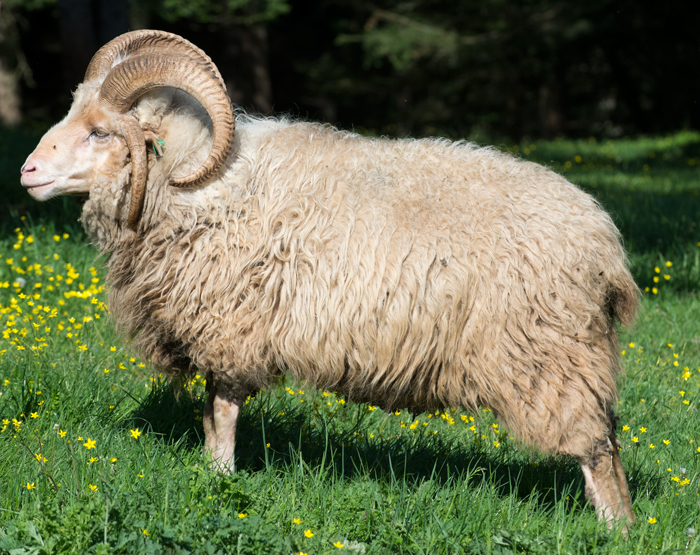
HtP Teddy Bear
From Hubbell Trading Post, Teddy Bear brings us a fresh infusion of absolutely unrelated blood to anything we already have. He's actually a very well behaved animal, and while he doesn't hesitate to step up aggressions with our other rams, he has offered no aggression towards humans at all, even during loading and transport. It's always a little sketchy to bring in a mature ram from somewhere else, especially when there's no real personal history on him, but we were confident that this guy would be worth the risk, and he proved us right. We were hoping that this guy would contribute many more years of his unique heritage and glossy fleece to our flock, and through his sons, he will.
Teddy Bear's Sire: Unknown.
Teddy Bear's Dam: Unknown.
This section is still under construction. Please check back soon for updates!
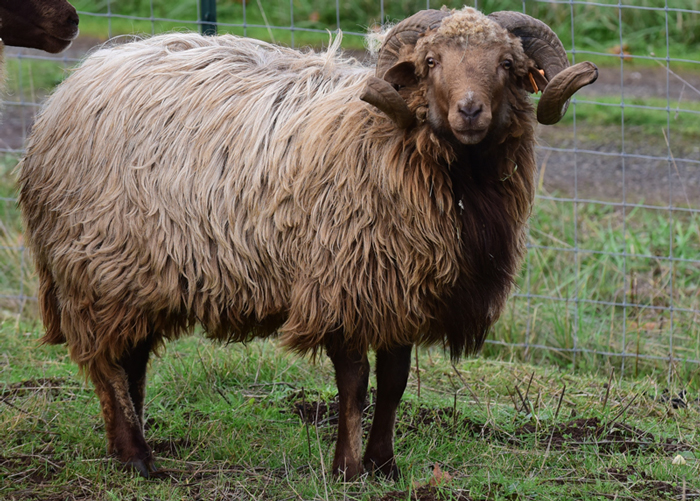
CNF Crockett
Crockett here is one gorgeous and solid yearling. As soon as I saw him at Cunnington Farms, I knew that he was just the ticket for adding outer coat to some of our lines of sheep. His demeanor was very mellow, and he remains a gentle ram despite being at the age when most of them begin acting like real jerks. He's a four horned ram with perfectly fused horns on both side, and we expect him to pass this trait along, as his sire was a 6 horn fused ram. His eyelids are perfect, without even a trace of a type II split, and he has open enough horns that we don't expect any issues with jaw or cheek crowding down the line. His fleece is well defined, and although it is far coarser than any of our other rams, it is low kemp and has a distinct undercoat. We'll be pairing him with ewes who have the densest undercoat and the weakest outercoat, in the hopes of lambs with a better balanced fleece. A solid, open outer coat like this guy has is exactly what we want to see in our wetter climate, because it protects the inner fleece from cotting and felting during the winter wet.
Crockett's Sire: OVR Bullmoose (N-CSA #6888-14); Sire's Sire: HtP Ganado (N-CSA #6588-12); Sire's Dam: CNF Fauna (N-CSA #5781-10).
Crockett's Dam: CNF Carmelita Suzanne (N-CSA #A555-08); Dam's Sire: Mel Gibson (N-CSA #4771-06); Dam's Dam: CNF Belle Stanton (N-CSA #4793-06).
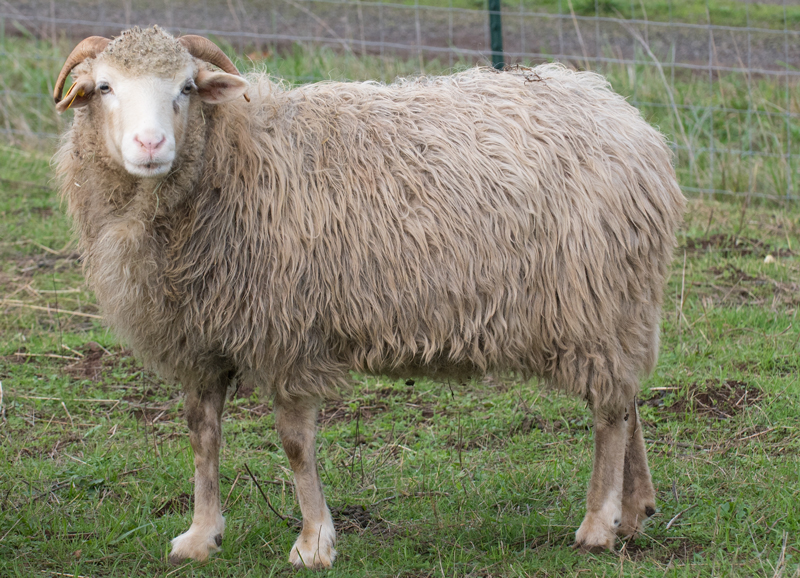 CNF Mariah Carey (N-CSA #5624-09);
CNF Mariah Carey (N-CSA #5624-09);
Mariah Carey is getting pretty high up there in years. We'd actually retired her from breeding for three years, because one of her sons was our ram for a bit, but he's since been sold and she was looking sleek, so we threw her in for one last round with Crockett. She has an excellent coat, with a well developed inner and outer coat, but many of her lambs have been heavier on the inner coat. This is great for hand spinning, but problematic in Oregon's climate. We're hoping that Crockett's amazing outer coat will pass down, resulting in lambs with a better fleece balance.
Mariah Carey's Sire: ALG Gandalf II; Sire's Sire: ALG 4 Horn White; Sire's Dam: Unknown.
Mariah Carey's Dam: CNF Marie Osmund (N-CSA #B3161-02); Dam's Sire: CNF Dutch (N-CSA #A2146-98); Dam's Dam: CMW Shitake (N-CSA #A2274-98).
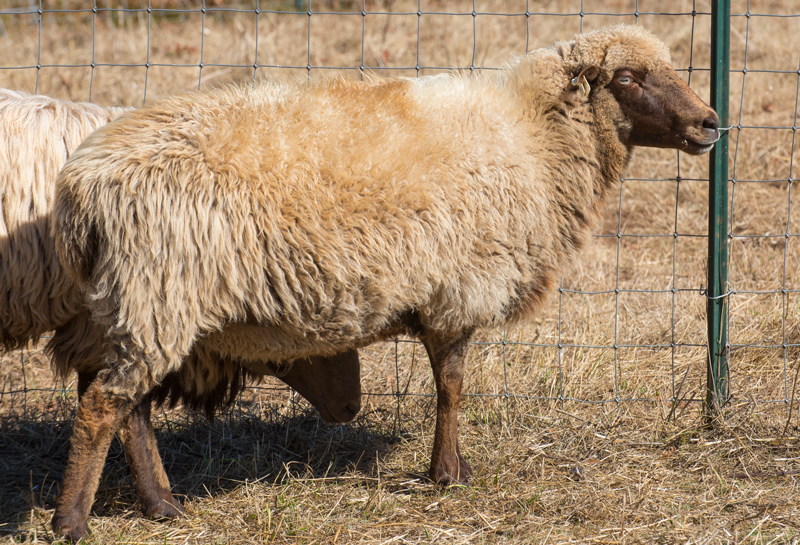 DoT Lt. McKay
DoT Lt. McKay
Lt. McKay is one good sized girl. She's a Mel Gibson daughter by one of our Utah ewes, from the small flock that Mickey traded a Charolais steer for back in 2012. Tall and clean legged, Lt. McKay used to get a little fuzzy in the winter, but she's losing that trait as she matures. Like many of the Utah sheep, she has a little less of an outer coat than some of our other Churros, so we're really looking forward to seeing what Crockett does to her lambs' fleeces. Regardless of how they come out, Lt. McKay is a spinner's favorite, so we're assured that her lambs will be quality.
Lt. McKay's Sire: Mel Gibson (N-CSA #4771-06); Sire's Sire: Griffindor; Sire's Dam: Yak (N-CSA #3157-02).
Lt. McKay's Dam: Ben Slatter's Godiva (N-CSA #6797-13); Dam's Sire: Ben Slatter's Rambo; Dam's Dam: BS Sumatra (N-CSA #6796-13).
 FCC Shadow (N-CSA #6794-13)
FCC Shadow (N-CSA #6794-13)
Shadow is a venerable ewe, but she's finally hit a point where we're going to permanently retire her from breeding. A lot of Churro ewes tend to lose their outer coats with age, with it getting a bit more scrawny and fragile each year, but Shadow has had a very long lasting and distinctive fleece. Her luster is amazing, although she does tend to make a bit more lanolin than most of our other ewes, so her wool must be washed before being carded. Crockett has a drier fleece, and we're hoping that the combination of the two will result in lambs that still have great luster, but a little less yolk in their coat. If Shadow has any ewe lambs this year, they will be held back, and she will be available for a retirement home WITHOUT RAMS.
Shadow's Sire: Unknown; Sire's Sire: Unknown; Sire's Dam: Unknown.
Shadow's Dam: Unknown; Dam's Sire: Unknown; Dam's Dam: Unknown.
 FCC Marita's Girl
FCC Marita's Girl
Marita's Girl is another one of our senior ladies. Her fleece has some seriously stacked undercoat, and her summer shearings are absolutely amazing to spin and felt. Her winter fleeces are almost always unusable, as she is a ewe who had an outer coat that deteriorated from age, and during the wet season, she turns into a wool felted oven mit. We're certain that Crockett's influence will give us some absolutely stunning lambs, and as both Marita's Girl and Crockett are super easy going animals, we fully expect their lambs to have great temperaments. This may be Marita's Girl's last breeding, as she is showing some pretty serious tooth wear. Any ewe lambs that may result will not be for sale.
Marita's Girl's Sire: Unknown; Sire's Sire: Unknown; Sire's Dam: Unknown.
Marita's Girl's Dam: baw Marita (N-CSA #B3248); Dam's Sire: CNF Holiday (N-CSA #B2893-01); Dam's Dam: baw Olivia (N-CSA #A1887-01).
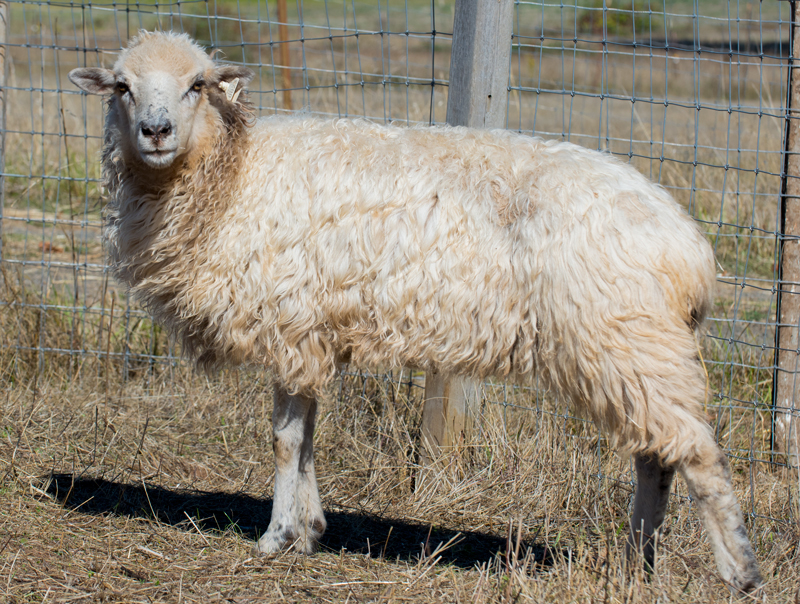 CNC Cowrie
CNC Cowrie
Cowrie is one of those ewes who just took my heart and squeezed it right out of my lips in the words "I want THAT one!". She came to us from Kelly Skacy of Coppermine's Navajo Churro, in Coppermine, AZ. When I first saw her, she leaped into the air higher than the heads of all the other ewes around her, and her wool flashed in the sun like the inside of a cowrie shell. Luckily for me, Kelly and her family allowed me to trade for this amazing ewe. With fleece that speaks for itself, Cowrie is low kemp and big on heart. A friendly ewe when she decides she likes you, Cowrie won't put up with crap from anybody, sheep, dog, or human. There's just something about this ewe that makes my heart sing every time I look at her. We're hoping that Cowrie's perfect, lustrous and finer than average fleece will help temper the ultra coarse coat that Crockett has, yet still produce a lamb with a stout coat that withstands our snowy and wet winters. She's a bit larger bodied than Crockett is, which is also a real bonus. We can't wait to see what these two will produce!
Cowrie's Sire: Unknown; Sire's Sire: Unknown; Sire's Dam: Unknown.
Cowrie's Dam: Unknown; Dam's Sire: Unknown; Dam's Dam: Unknown.
